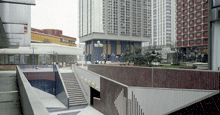
Today as in the past, all growing metropoles whose territories are at first view limited, ask themselves questions about the possibility of vertical urban development. Among the measures which are potentially able to render a landholding profitable are slabs and towers, both of which often suffer from a bad reputation. Numerous examples which are considered as negative are to be found among the big building complexes in Paris where ground cover dominates, isolating them from their surrounding urban context. The question raised is therefore, what are the conditions under which artificial land can be successful and work in osmosis with the surrounding city? As the final report on research carried out for Apur by Jean Castex, Catherine Blain and Virginie Lefebvre, teachers and researchers of architecture at the Versailles Architecture School LADRAUS, this study presents a cross-analysis of three examples, in New York, Boston and Montreal, which show how the issue of vertical urbanism using the tower and slab principle has been approached in the past and present in North America, in order to respond both to the high demand for land and the growing need for access to city centres. Are there lessons to be leant here by us in Paris?
